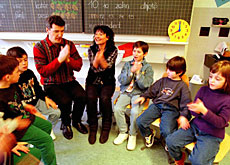
Balkan migrants struggle to integrate

Immigrants from the former Yugoslavia now make up one of the largest migrant communities in Switzerland. But many are finding it hard to integrate.
Although respected in the past for being hard workers, their image in Switzerland has been tarnished by a small minority which is involved in crime and violence.
At 213,900 people, migrants from Serbia and Montenegro make up the second largest group of foreigners after the Italians (312,000), according to statistics for 2003.
But taken all together, immigrants from the former Yugoslavia – Serbia and Montenegro, Croatia, Bosnia-Herzegovina, Macedonia and Slovenia as well as Kosovo – actually number around 370,000 people.
In the past three years, migrants from the Balkans have also been the most active in obtaining Swiss citizenship, with a third of newly issued passports being granted to them in this period. Many of them have been in Switzerland for a long time.
But despite the fact that the Yugoslav federation no longer exists, people from the region are still often collectively referred to as “Yugos” in Switzerland.
The label has acquired negative connotations, but this was not always so.
Dejan Mikic, a Zurich citizen of Serbian origin, who came to Switzerland in 1967, remembers an occasion in the early 1980s when newspapers ran the headline “The Yugos are coming” with a sense of awe and respect to announce the arrival of a formidable handball team.
Diligent workers
The first wave of immigration from the Balkans brought highly qualified engineers, doctors and dentists to Switzerland, following an agreement between Bern and Belgrade in 1965.
This was followed almost immediately by an influx of seasonal workers.
However, the situation changed after the death of the former Yugoslav leader Marshal Tito in 1980. The resulting deterioration in social and economic conditions drove many of the poorer citizens to look for alternative employment abroad.
The outbreak of war in the Balkans in 1991 led to a further worsening of conditions and different types of migrants.
“There was a change in the social and demographic structure of the migrants concerned,” said Philippe Wanner, director of the Swiss Forum for Migration and Population Studies (SFM).
“Whereas the earlier wave consisted of single workers, after the war whole families and refugees began arriving in Switzerland.”
A few bad apples…
Despite moves by the government to stem the influx of migrants from the Balkans, those already in Switzerland continued to be joined by their families – with almost 200,000 new arrivals in ten years. Attitudes towards them started to change.
“Drug traffickers and people with local mafia connections slipped in among the genuine refugees,” said Wanner.
Though few in number, experts say these people seriously damaged the image of Balkan immigrants.
The situation is not helped by crime statistics. A recent study found that among foreigners sentenced for crimes in Switzerland, the figure for people from the former Yugoslavia increased from 20 per cent in 1991 to 28 per cent in 1998.
But experts warn that the figures do not give the whole story. They say that Albanian mafia criminals only make up a very small minority of the 200,000 Albanians living in Switzerland.
Difficult social circumstances – both in the homeland and the host country – are also said to be a factor.
“Apart from the horrors experienced by people from the former Yugoslavia, often difficult to imagine, it is important to bear in mind that the host society also has a vital role to play,” says Janine Dahinden, who also works for the SFM.
Discrimination
She says that Switzerland is partly to blame for some of the failures in integrating these immigrants. One person of Balkan origin in five was born in the country, she adds. But it still remains difficult to obtain Swiss citizenship.
Dahinden also points out that discrimination and racism are still rife, particularly in the workplace.
Recent research has suggested that having an Albanian name is enough to severely limit a person’s chances of finding a job, even if they have the same qualifications as a Swiss citizen.
But the future looks brighter, at least according to Ludwig Hasler, a professor who has written a book on the subject of Balkan immigration to Switzerland.
“In 30 years we shall be saying: it is great to have people from the Balkans living here. They contribute a note of melancholy colour to the prevailing greyness of our Swiss music.”
swissinfo, Luigi Jorio
There are around 370,000 immigrants from the former Yugoslavia, according to statistics for 2003.
In 1990 there were 172,777, in 1980 60,916 and in 1970 24,971.
Most come from Kosovo (36%), followed by Serbia and Montenegro (22%), Macedonia (16%), Bosnia (14%) and Croatia (12%).
According to some experts, not all the population groups from the former Yugoslavia living in Switzerland are facing the same problems.
Albanians are finding it more difficult to integrate than Serbs, Croats and Bosnians.
People from Kosovo and Macedonia suffer from a lack of education and training, with those from Kosovo suffering a high unemployment rate.

In compliance with the JTI standards
More: SWI swissinfo.ch certified by the Journalism Trust Initiative
















![The four-metre-long painting "Sonntag der Bergbauern" [Sunday of the Mountain Farmers, 1923-24/26] had to be removed by a crane from the German Chancellery in Berlin for the exhibition in Bern.](https://www.swissinfo.ch/content/wp-content/uploads/sites/13/2025/12/01_Pressebild_KirchnerxKirchner.jpg?ver=cb688ed5)















You can find an overview of ongoing debates with our journalists here . Please join us!
If you want to start a conversation about a topic raised in this article or want to report factual errors, email us at english@swissinfo.ch.